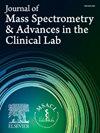Definitive urine drug testing in emergency medicine: Recreational and psychiatric drug findings
IF 3.4
4区 医学
Q2 MEDICAL LABORATORY TECHNOLOGY
Journal of Mass Spectrometry and Advances in the Clinical Lab
Pub Date : 2025-04-23
DOI:10.1016/j.jmsacl.2025.04.008
引用次数: 0
Abstract
Introduction
Clinical management of drug-related emergency department (ED) visits relies on available history, toxidrome findings and drug screening. In this study, definitive drug testing is used to assess ED drug prevalence and immunoassay drug screening performance.
Methods
Definitive testing for 116 drugs and metabolites was performed on urine from 400 ED patients, with comparison to immunoassay drug screening.
Results
Definitive testing resulted in 1,350 drug findings with prevalent use of nicotine (63%), cocaine (34%), ∆9 tetrahydrocannabinol (34%), fentanyl (17%), morphine or heroin (11%) and methamphetamine (6%). Forty percent of patients were also positive for antidepressants and 24% positive for antipsychotics. Significant patterns of co-drug use were found for cocaine, fentanyl, morphine and nicotine. Multi-serotonergic drug use was frequent, suggesting a risk for serotonin syndrome. Immunoassay performance showed high false negative rates for benzodiazepines (40%), amphetamines (38%), barbiturates (33%), opiates (25%), methadone (20%) and cocaine (16%), along with inaccuracy in phencyclidine detection. Immunoassay missed 890 of the 1,350 drug findings by definitive testing, due to either high cutoff thresholds or limited testing scope.
Discussion
A high prevalence of drugs use by ED patients is evidenced with frequent co-use of illicit and therapeutic drugs and with potential for unrecognized multi-serotonergic drug interactions. This study also shows the limitations of immunoassay drug testing in both scope and sensitivity, with a high rate of undetected drug use.
Conclusion
The study provides evidence-based support for recommended implementation of definitive drug testing in emergency medicine as a guide to clinical management in drug-related ED visits.
急诊医学的最终尿检:娱乐性和精神性药物的发现
药物相关急诊科(ED)就诊的临床管理依赖于现有病史、毒副反应结果和药物筛查。在这项研究中,明确的药物测试是用来评估ED药物流行和免疫测定药物筛选性能。方法对400例ED患者的尿液进行116种药物和代谢物的明确检测,并与免疫法药物筛选进行比较。结果最终检测出1350种药物,其中普遍使用尼古丁(63%)、可卡因(34%)、∆9四氢大麻酚(34%)、芬太尼(17%)、吗啡或海洛因(11%)和甲基苯丙胺(6%)。40%的患者抗抑郁药物检测呈阳性,24%的患者抗精神病药物检测呈阳性。在可卡因、芬太尼、吗啡和尼古丁中发现了显著的联合用药模式。多血清素能药物的使用频繁,提示患血清素综合征的风险。免疫分析结果显示,苯二氮卓类药物(40%)、安非他明(38%)、巴比妥类药物(33%)、阿片类药物(25%)、美沙酮(20%)和可卡因(16%)的假阴性率较高,苯环利定检测不准确。在1350种药物的最终检测中,由于阈值过高或检测范围有限,免疫分析法遗漏了890种。ED患者药物使用的高流行率表明,经常同时使用非法药物和治疗药物,并且可能存在未被识别的多种血清素能药物相互作用。本研究还显示了免疫测定药物检测在范围和灵敏度上的局限性,未被检测到的药物使用率很高。结论本研究为建议在急诊医学中实施明确的药物检测作为药物相关急诊科就诊的临床管理指南提供了循证支持。
本文章由计算机程序翻译,如有差异,请以英文原文为准。
求助全文
约1分钟内获得全文
求助全文
来源期刊

Journal of Mass Spectrometry and Advances in the Clinical Lab
Health Professions-Medical Laboratory Technology
CiteScore
4.30
自引率
18.20%
发文量
41
审稿时长
81 days
 求助内容:
求助内容: 应助结果提醒方式:
应助结果提醒方式:


